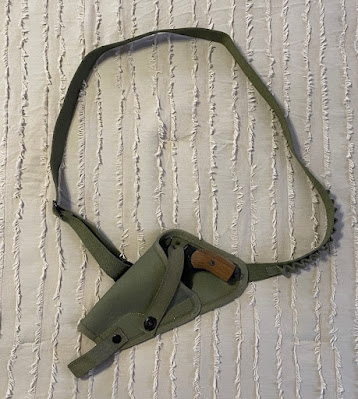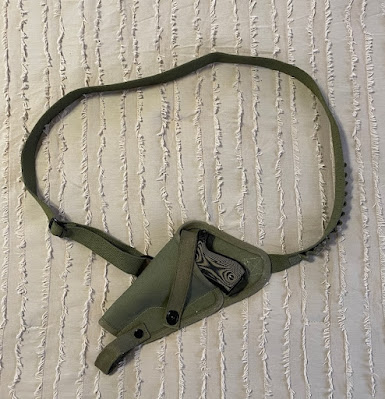Last year I posted about the virtues of the M3 Tanker Holster. I have copies of those made for the M1911 and the S&W Victory Model, and a really nice version from El Paso Saddlery for my S&W Model 28 N-Frame. Today I received a canvas version of the Victory Model holster by World War Supply. I bought it from Amazon to take advantage of points I have, but it's also available directly from WWS.
Aside from 4" K-Frames, it fits a variety of other guns:
Russian M-1895 Nagant:
High Standard Sentinel .22:
Ruger Speed Six:
And even the Beretta Model 81 .32 ACP autoloader fits comfortably:
Note that I have the Beretta in there cocked and locked with the retention strap between the hammer and firing pin, just in case the safety gets nudged off by accident.
The Beretta Model 84 in .380 is externally identical to the Model 81 so it'll work as well.
During WW2 the Victory Model holsters were also used for Colt Commando revolvers, so it should work for an Army Special or Official Police with a 4" or shorter barrel.
I didn't try it in this one but my leather Victory Model holster works well with a Webley Mk.IV in .38/200.
The 12 cartridge loops on the strap are intended for .38 Special rounds but appear snug enough for .32 S&W Long. They should be fine for 7.62x38R Nagant ammo or .32-20.
World War Supply also has a canvas version of the holster for the M-1911.
The canvas fabric appears to be of good quality and the stitching is done well. These holsters cost $34.99 and at this price point appear to be a great deal with a lot of versatility. As a southpaw I appreciate it that WWS sells left handed versions of this design at the same price as the right handed holsters.
If you prefer leather those versions are only a few dollars more.















